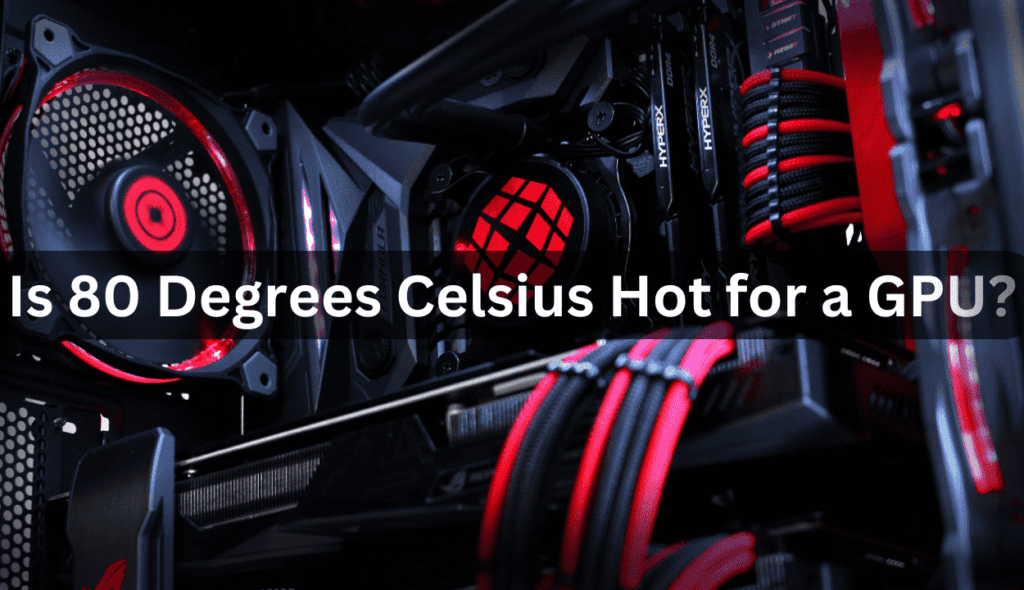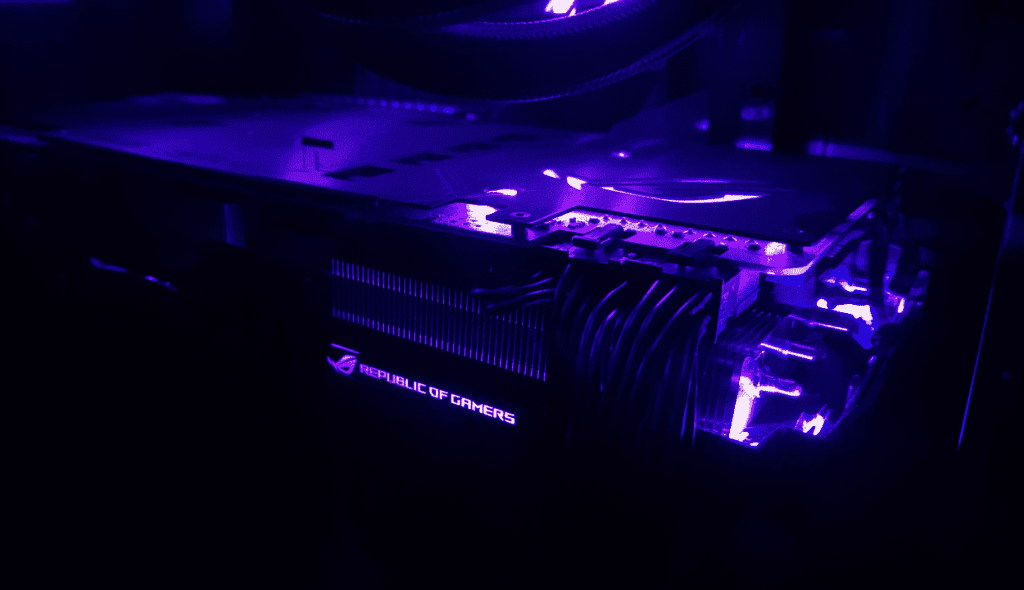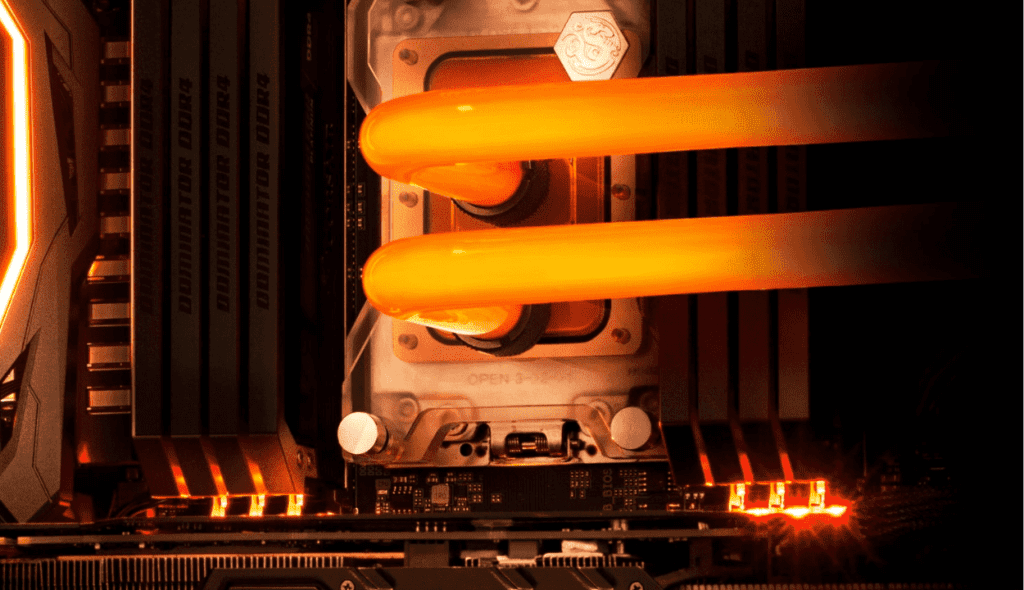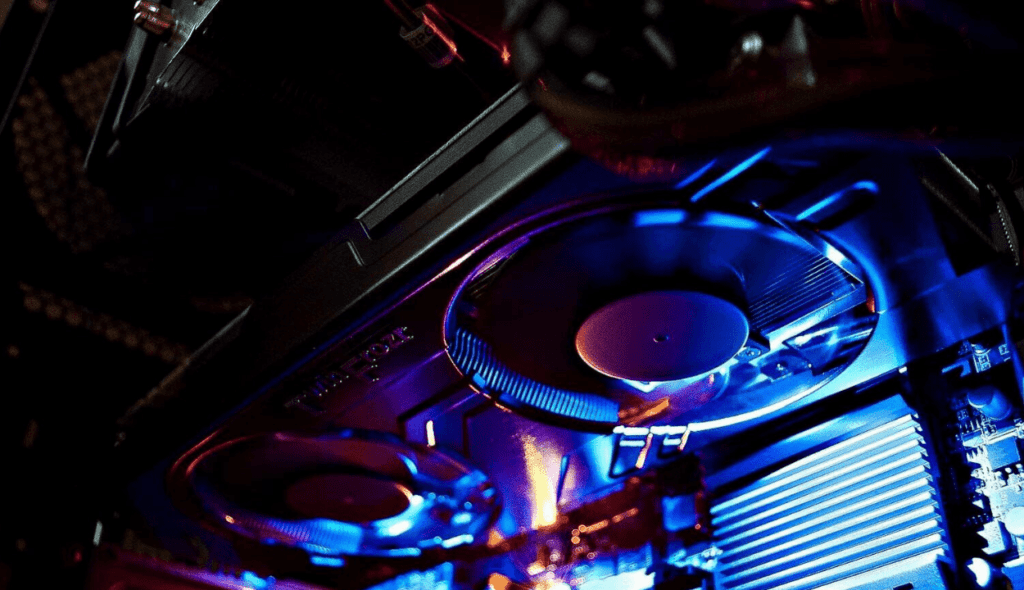
Is 80 Degrees Celsius Hot For A GPU? How hot is too hot for your GPU? We need to find ways to keep them cool so they can run smoothly and last a long time.
Yes, 80 degrees Celsius is hot for a GPU but not immediately dangerous.While most models can handle it, it’s best to lower it for optimal performance and lifespan.
In this article, we’ll explore if 80 degrees Celsius is hot for modern GPUs. We’ll cover safe temperature ranges for various GPU brands and models, along with tips to maintain cool temperatures during long gaming sessions.
Understanding GPU Temperature?
A GPU is an essential component in any gaming PC or workstation. It powers the visuals you see on the screen and allows for a smooth gameplay experience. However, GPUs generate a lot of heat due to the immense amount of power required to render graphics. This heat needs to be properly managed to prevent damage to your GPU.
What is a Safe Operating Temperature for a GPU?
In general, a GPU temperature under 80°C or 175°F during intensive tasks like gaming is considered normal and safe. Anything over 90°C for extended periods of time can potentially reduce the lifespan of your GPU. The ideal temperature range for most GPUs during full load is 65 to 78°C.
Some tips to keep your GPU running cool:
- Improving case airflow by adding more fans or upgrading to a case with a mesh front panel.
- Adjusting your GPU’s fan curve to spin up faster, which can lower temps by 5-10°C.
- Reapplying high-quality thermal paste between the GPU die and heatsink. This can sometimes drop temps by several degrees.
- Undervolting your graphics card, which reduces power draw and heat output with minimal performance impact.
- Limit your frame rates. Frame rates over your monitor’s refresh rate simply generate excess heat. Use a frame limiter to cap rates at 60-144 FPS.
- Repaste your GPU with fresh thermal paste. Over time, the pre-applied paste can dry out and lose effectiveness. Fresh paste helps transfer heat from the GPU die to the cooler more efficiently.
- Improving ambient temperatures in your room. The cooler your room, the more effective your PC’s cooling will be.
- Consider water cooling for high-end GPUs. Liquid cooling is very effective at taming temperatures and ideal for overclocking. But it may require some technical know-how to get started.
By following these tips, you can feel confident your GPU is running at a safe and stable temperature for maximum performance. But if temperatures do spike over 90°C, it’s best to stop gaming and troubleshoot to avoid any permanent damage.
What Is a Normal GPU Temperature?
A normal GPU temperature depends on the graphics card you have installed, as well as factors like workload and cooling. However, as a general rule of thumb, a GPU temperature of 80°C or below under load is typically considered normal and safe for most graphics cards. Anything over 90°C is usually a cause for concern and could indicate potential overheating issues.

Light Gaming and Desktop Use
- For casual gaming and regular desktop use, your GPU temperature should stay in the 60-70°C range. At idle or when performing light tasks like web browsing, a temperature of 45-55°C is common. If your GPU is running hotter than this during basic use, you may need to improve your case airflow or reapply thermal paste.
Heavy Gaming
- When playing graphics-intensive games for extended periods, it’s normal for your GPU temperature to rise into the 70-80°C range. The more demanding the game and the higher your graphics settings, the hotter your GPU is likely to run. As long as it stays under 85°C, this type of load temperature is usually considered safe for most graphics cards, but you may want to limit gaming sessions to prevent overheating.
Benchmarking and Stress Testing
- Running GPU benchmark tools or stress tests pushes your graphics card to its limits, so temperatures of up to 85°C can be expected. However, for prolonged testing, it’s best to keep temperatures in the 70-80°C range. If your GPU climbs above 90°C during stress testing, it could indicate a cooling issue and risks causing permanent damage.
Making simple adjustments like improving case airflow, cleaning fans and heat sinks, reapplying thermal paste, or undervolting/underclocking your GPU can significantly help lower temperatures if needed.
How Hot is too Hot for GPU
If your GPU is running at 80 degrees Celsius under load, should you be worried? The short answer is: probably not.

Normal Operating Temperature
- Most modern GPUs are designed to operate at temperatures between 65 to 85 degrees Celsius without issues. Your GPU should be able to maintain this temperature during standard loads, such as gaming, video editing or other graphics intensive tasks. At 80 degrees, your GPU is running on the higher end of the normal range, but is still considered safe for most graphics cards.
Overheating Risks
- However, if your GPU is constantly running over 85 degrees for long periods, it’s a good idea to improve your cooling. Prolonged exposure to high heat can potentially reduce the lifespan of your graphics card over time. It can also lead to temporary throttling, where your GPU decreases its performance to avoid overheating. In a worst case scenario, excessively high temperatures (95°C+) could potentially cause permanent damage.
Improve Cooling
- If you’re concerned about temperatures around 80 degrees, there are a few ways to improve cooling and bring your GPU back to a lower, safer range. Make sure your computer case fans are clear of dust and spinning properly. You can also install additional case fans to increase airflow. Undervolting your GPU can help reduce heat, as can ensuring your graphics card’s fans are also dust-free and spinning at maximum RPM under load.
Is 80 Degrees Celsius Hot for a GPU?
Yes, 80°C is on the higher end of the temperature range for most GPUs. While 80°C won’t immediately damage your graphics card, running at this temperature for extended periods of time can potentially reduce its lifespan. The ideal temperature range for a GPU under normal loads is usually between 65 to 78°C. Anything over 80°C is considered quite warm and may throttle your GPU’s performance to prevent overheating.
High temps can impact performance and longevity.
- When your graphics card starts running too hot, it will automatically downclock itself to produce less heat, which results in lower performance. Constantly running at higher temperatures can also degrade components over time and reduce the overall lifespan of your GPU. The hotter a GPU runs, the faster it ages—so keeping temperatures in check is important for stability and longevity.
What is Maximum CPU Temperature?
80°C is a bit on the warmer side for a graphics card, but still considered normal during intense usage. However, letting your GPU run at this temperature for extended periods of time can reduce its lifespan. The maximum recommended operating temperature for most GPUs is 95 to 105°C, so while 80°C shouldn’t cause any immediate damage, it’s a good idea to improve cooling if you frequently see temperatures approaching 90°C.
What Factors Affect GPU Temperatures?
The temperature of your graphics card, or GPU, depends on a few key factors. Understanding how these factors work together can help you keep your GPU running cool and prevent overheating.
1. GPU Usage and Load
- One of the biggest influences on GPU temperature is how hard it’s working, known as GPU usage or load. When your GPU is tasked with rendering complex graphics like 4K video editing or playing graphics-intensive PC games, its temperature will rise substantially. Less demanding tasks like web browsing typically won’t heat up your GPU much at all.
2. Case and Cooling
- The case and cooling components of your PC also play an important role in GPU temperature regulation. Most GPUs exhaust their hot air inside your PC case, so good airflow is essential. Make sure your case has adequate ventilation and cooling fans to remove this hot air. Liquid cooling systems can also help significantly lower GPU temperatures under load.
3. Ambient Room Temperature
- The ambient temperature of the room your PC is in will directly affect how hot your GPU gets. All else being equal, a GPU will run cooler in a room that’s 65 F versus 85 F. Try to keep your PC in a cool area of your home away from heat vents.
4. Overclocking
- Overclocking your GPU will generate more heat, since you’re forcing it to operate at higher clock speeds than the manufacturer’s default. Only overclock if you have excellent cooling and temperature monitoring in place. Overclocking too aggressively can drastically reduce the lifespan of your graphics card.
While 80 C is still considered a safe temperature for most GPUs under load, lower is generally better. If temperatures start frequently spiking into the 90s, it’s time to improve your cooling. A temperature-related GPU failure is often preventable with some common sense safeguards.
How to Keep Your GPU Cool
A GPU—or graphics processing unit—is designed to handle intensive tasks like gaming, video editing, and cryptocurrency mining. But all that performance comes at a cost: heat. If your GPU temperature gets too hot, it can throttle performance or even become permanently damaged. So keeping your GPU cool is important.

The ideal temperature range for most GPUs under load is 65-85°C or 149-185°F. Anything over 90°C or 194°F is usually considered too hot and may reduce performance or lifespan.
There are a few ways you can help lower your GPU temperature.
- First, make sure your computer case has good airflow. Add or upgrade case fans to pull hot air away from your graphics card. You can also improve airflow by removing any unused expansion slot covers on your case.
- You may also want to consider reapplying high-quality thermal paste between your GPU chip and its cooling unit. Over time, the original thermal paste can dry out and lose effectiveness. Fresh thermal paste helps transfer heat away from the GPU chip to the cooler more efficiently.
- Undervolting and underclocking your graphics card can significantly reduce heat. Undervolting lowers the power supplied to the GPU, while underclocking lowers the GPU’s clock speed. You may lose a small amount of performance, but temperatures can drop by 10°C or more. Many graphics cards allow you to undervolt and underclock within the card’s software.
- As a last resort, you can install an aftermarket GPU cooler to replace your graphics card’s stock cooler. High-performance coolers from brands like Arctic and EVGA can lower load temps by up to 30°C compared to stock coolers. But GPU coolers do require removing your existing cooler, so proceed carefully.
Keeping an eye on your GPU temperature and making adjustments when needed will help ensure peak performance and a long lifespan for your graphics card. Staying within safe operating temperatures means your GPU can handle any workload without overheating—and without you needing to worry if 80°C is too hot!
FAQs
Is 80°C too hot for my GPU?
- 80°C is near the upper limit for most GPUs, but not dangerous. While some models can handle it better than others, it’s best to keep it below 80°C for optimal performance and lifespan.
What factors affect my GPU temperature?
- GPU usage and load, case and cooling, ambient room temperature, and overclocking all affect GPU temperatures.
Should I be worried if my GPU reaches 85°C or higher?
- Yes, temperatures above 85°C are concerning. Shut down your computer and investigate. Check for fan issues, excessive dust, or software problems. Consider undervolting or upgrading cooling solutions.
What is the safe operating temperature for a GPU?
- Generally, a GPU temperature under 80°C during intensive tasks like gaming is considered normal and safe. Anything over 90°C for extended periods can potentially reduce its lifespan.
Can I damage my GPU if it gets too hot?
- Yes, sustained high temperatures can shorten your GPU’s lifespan and even cause permanent damage.
What are some tips to keep a GPU running cool?
- Some tips include ensuring good airflow in your case, setting a more aggressive fan curve, undervolting your GPU, limiting frame rates, repasting with fresh thermal paste, and considering water cooling for high-end GPUs.
Conclusion
- In conclusion, while 80 degrees Celsius is indeed on the warmer side for a GPU, it typically falls within the normal operating range for most graphics cards.
- While prolonged exposure to such temperatures may slightly reduce the lifespan of your GPU, it’s generally not an immediate cause for concern.
- However, aiming for lower temperatures, ideally between 65 to 75 degrees Celsius, can help optimize performance and ensure the longevity of your graphics card.
- By implementing proper cooling strategies and monitoring your GPU’s temperature, you can enjoy smooth gaming experiences without worrying about overheating issues.